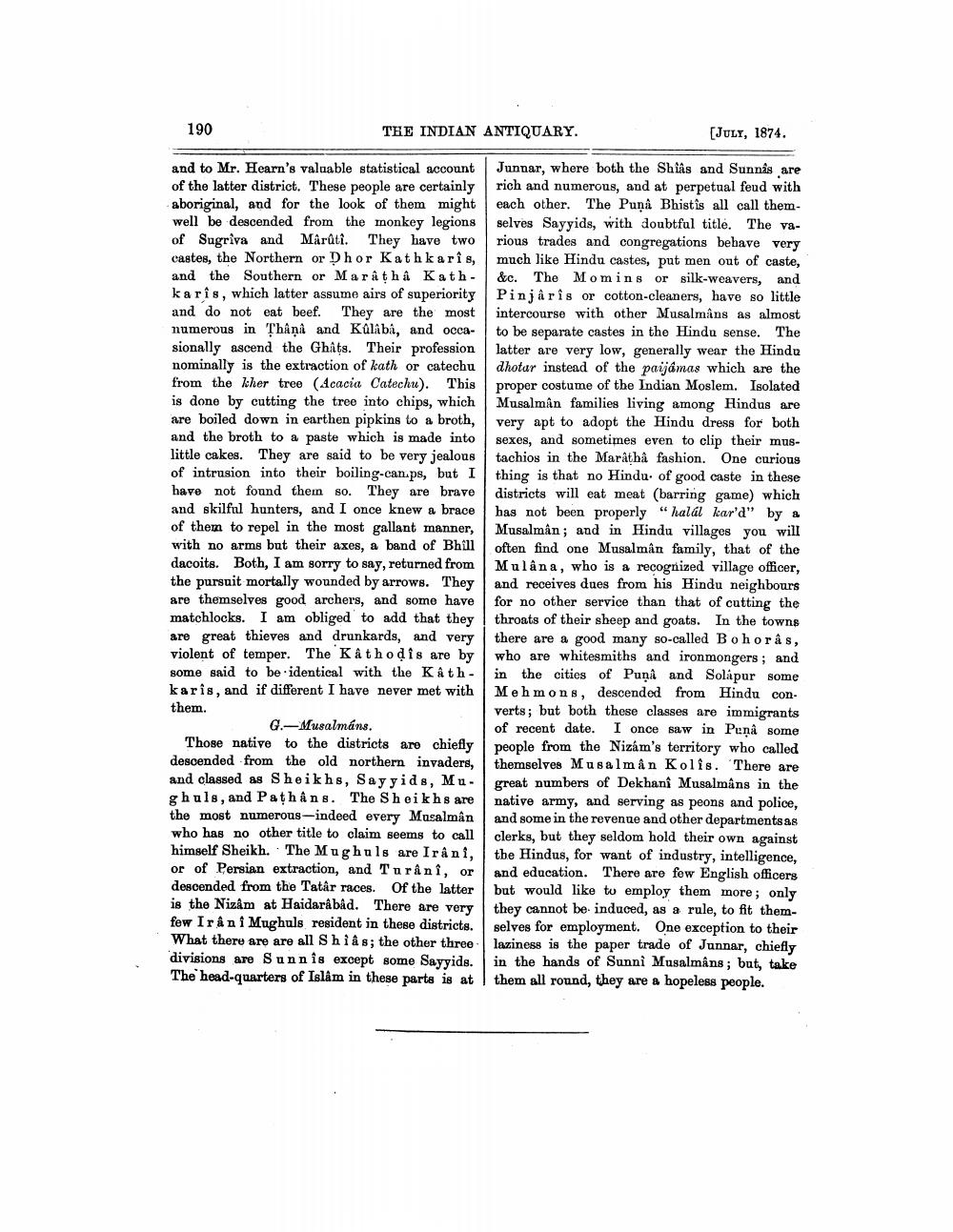________________
190
THE INDIAN ANTIQUARY.
and to Mr. Hearn's valuable statistical account of the latter district. These people are certainly aboriginal, and for the look of them might well be descended from the monkey legions of Sugriva and Mârâti. They have two castes, the Northern or Dhor Kathkarîs, and the Southern or Maratha Kathkaris, which latter assume airs of superiority and do not eat beef. They are the most numerous in Thâna and Kûlâbâ, and occasionally ascend the Ghats. Their profession nominally is the extraction of kath or catechu from the kher tree (Acacia Catechu). This is done by cutting the tree into chips, which are boiled down in earthen pipkins to a broth, and the broth to a paste which is made into little cakes. They are said to be very jealous of intrusion into their boiling-can.ps, but I have not found them so. They are brave and skilful hunters, and I once knew a brace of them to repel in the most gallant manner, with no arms but their axes, a band of Bhill dacoits. Both, I am sorry to say, returned from the pursuit mortally wounded by arrows. They are themselves good archers, and some have matchlocks. I am obliged to add that they are great thieves and drunkards, and very violent of temper. The Kathoḍis are by some said to be identical with the Kathkaris, and if different I have never met with them.
G.-Musalmans.
Those native to the districts are chiefly descended from the old northern invaders, and classed as Sheikhs, Sayyids, Mughuls, and Pathâns. The Sheikhs are the most numerous-indeed every Musalmân who has no other title to claim seems to call himself Sheikh. The Mughuls are Irâni, or of Persian extraction, and Turânî, or descended from the Tatâr races. Of the latter is the Nizâm at Haidarâbâd. There are very few Irâni Mughuls resident in these districts. What there are are all Shiâs; the other three divisions are Sunnis except some Sayyids. The head-quarters of Islâm in these parts is at
[JULY, 1874.
Junnar, where both the Shiâs and Sunnås are rich and numerous, and at perpetual feud with each other. The Punâ Bhistis all call themselves Sayyids, with doubtful title. The various trades and congregations behave very much like Hindu castes, put men out of caste, &c. The Momins or silk-weavers, and Pinjâris or cotton-cleaners, have so little intercourse with other Musalmâns as almost to be separate castes in the Hindu sense. The latter are very low, generally wear the Hindu dhotar instead of the paijamas which are the proper costume of the Indian Moslem. Isolated Musalman families living among Hindus are very apt to adopt the Hindu dress for both sexes, and sometimes even to clip their mustachios in the Maratha fashion. One curious thing is that no Hindu. of good caste in these districts will eat meat (barring game) which has not been properly "halál kar'd" by a Musalmân; and in Hindu villages you will often find one Musalmân family, that of the Mulâna, who is a recognized village officer, and receives dues from his Hindu neighbours for no other service than that of cutting the throats of their sheep and goats. In the towns there are a good many so-called Bohorâs, who are whitesmiths and ironmongers; and in the cities of Punâ and Solapur some Mehmons, descended from Hindu converts; but both these classes are immigrants of recent date. I once saw in Punâ some people from the Nizám's territory who called themselves Musalman Kolis. There are great numbers of Dekhani Musalmâns in the native army, and serving as peons and police, and some in the revenue and other departments as clerks, but they seldom hold their own against the Hindus, for want of industry, intelligence, and education. There are few English officers but would like to employ them more; only they cannot be induced, as a rule, to fit themselves for employment. One exception to their laziness is the paper trade of Junnar, chiefly in the hands of Sunni Musalmâns; but, take them all round, they are a hopeless people.




